The ArchiMate modeling language is designed to be compatible with the TOGAF framework; i.e., architects following the guidelines and best practices provided in the TOGAF framework can use the ArchiMate language to cover many of the modeling tasks, including the creation of views based on the various architecture viewpoints suggested in the TOGAF framework. The improvements made in ArchiMate 3.0 enable them seamlessly well integrated together:
The approximate mapping of the ArchiMate 3.0 modeling language to the TOGAF 9.1 Architecture Development Method (ADM) is described in the Figure below:
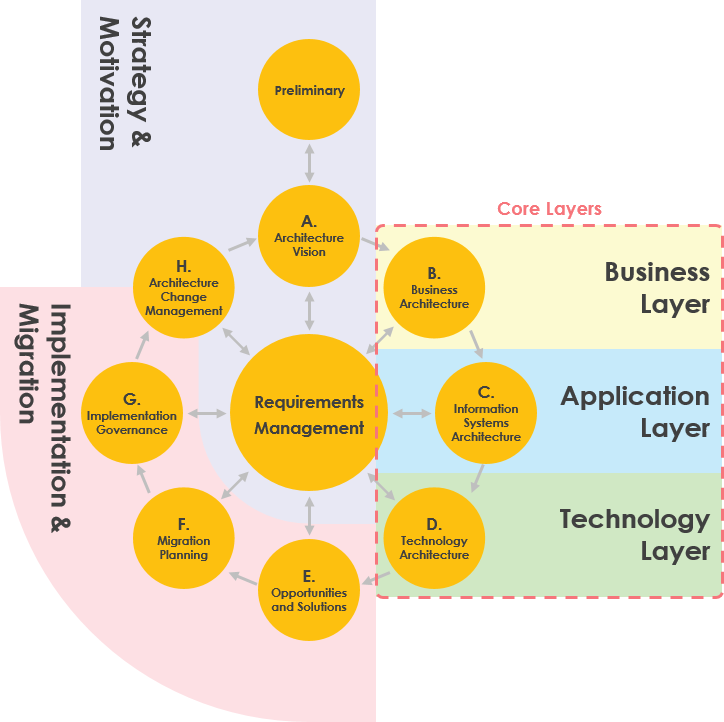
In addition to improvements in core elements in the Business, Application, and Technology Layers, the ArchiMate 3.0 standard adds several extensions that are relevant to an Enterprise Architecture practice:
A number of examples drawn from the ArchiSurance Case Study follow, illustrating extracts of models that might be developed during a TOGAF ADM cycle.
Principles in the TOGAF standard are established and maintained as part of the Preliminary Phase. This example shows how principles, their dependencies, and their goals can be represented in a graphical way.
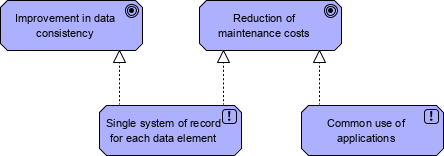
In the TOGAF standard, Phase A is concerned with establishing a high-level vision of the target architecture, across all the sub-domains of the Enterprise Architecture. An important part of this will be to establish and model the strategy of the business, and show how the architecture, and possible solutions that realize the architecture, implement the strategy.
Example: Strategy View
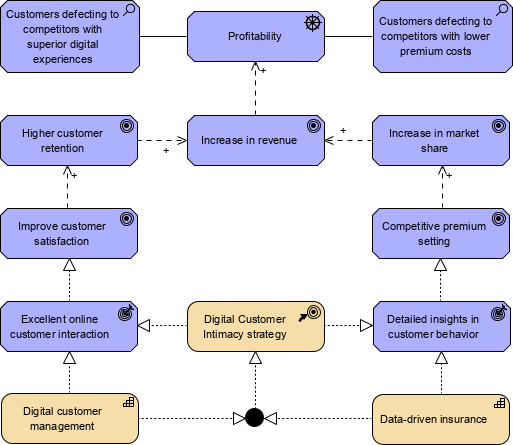
The Strategy viewpoint allows the Business Architect to model an overview of the courses of action chosen or considered by the enterprise, the capabilities and resources supporting them, the envisaged outcomes, and how these contribute to the organization’s goals and drivers.
Business Architecture models the business-related elements of the Enterprise Architecture. The TOGAF standard mentions that business processes are very important elements, in that they effectively orchestrate the use of all the other elements to create the value allied to the enterprise’s mission. The ArchiMate language is equipped to model the TOGAF Business Architecture graphically. However, the ArchiMate standard proposes a service-orientated architectural style, something that is specified in its core metamodel, as this style promotes maximum flexibility, re-use, and speed of change, at low cost and low risk. Business processes realize business services in this approach, where value is associated with the service.
Example: Business Processes
This example shows how two business processes could be modeled for a Business Architecture. This example shows the two central business processes of ArchiSurance, with their high-level sub-processes.
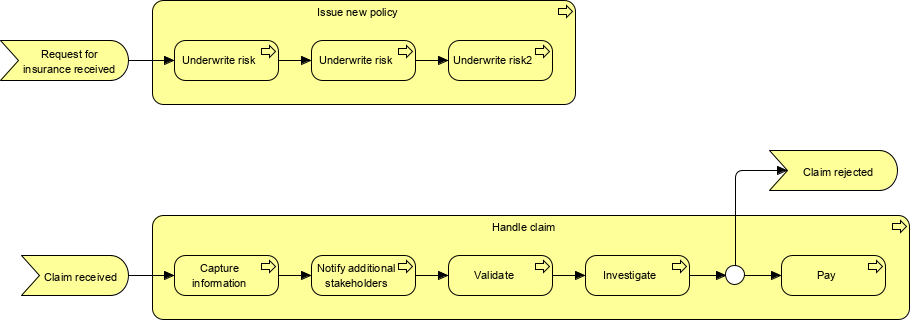
TOGAF Phase C covers Application and Data Architecture. These are treated as separate architecture subdomains in the TOGAF framework, but in the ArchiMate language data is an aspect of every architectural domain.
Example: Application Co-operation
This example shows how a number of applications co-operate, as well as the main data-flows between the applications.
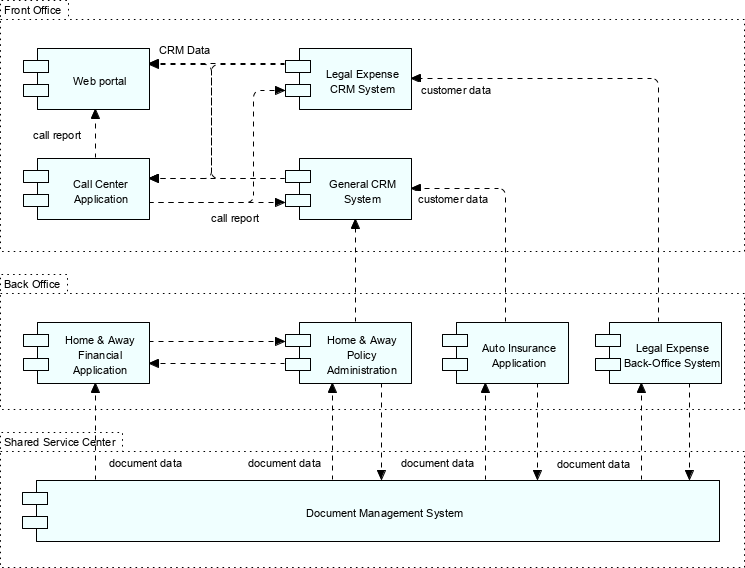
Example: Information Structure
This example shows how relationships between business objects might be modeled graphically. This is the ArchiMate version of the classic Conceptual Data Model.
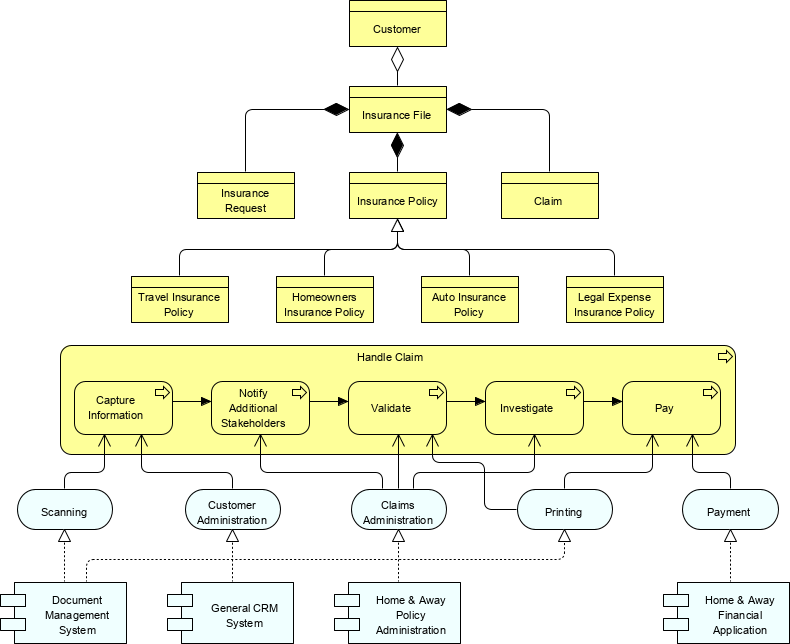
A common requirement in Business Architecture is to view the way applications and data support business processes. The figure above is an example of a cross-layer view and several cross-layer views could be constructed across different layers, in accordance with stakeholders’ requirements.
TOGAF Phase D deals with Technology Architecture, which shows how information technology can be deployed to realize the applications and data requirements defined in Phase C. The ArchiMate standard has a separate layer for Technology Architecture, in which technology such as devices, systems software, DBMS, and communications paths can be represented.
Example: Infrastructure
This example shows the main infrastructure components for an enterprise, grouped by location and department. Also, the networks that connect the different devices, and the (application) artifacts deployed on the devices, are shown.
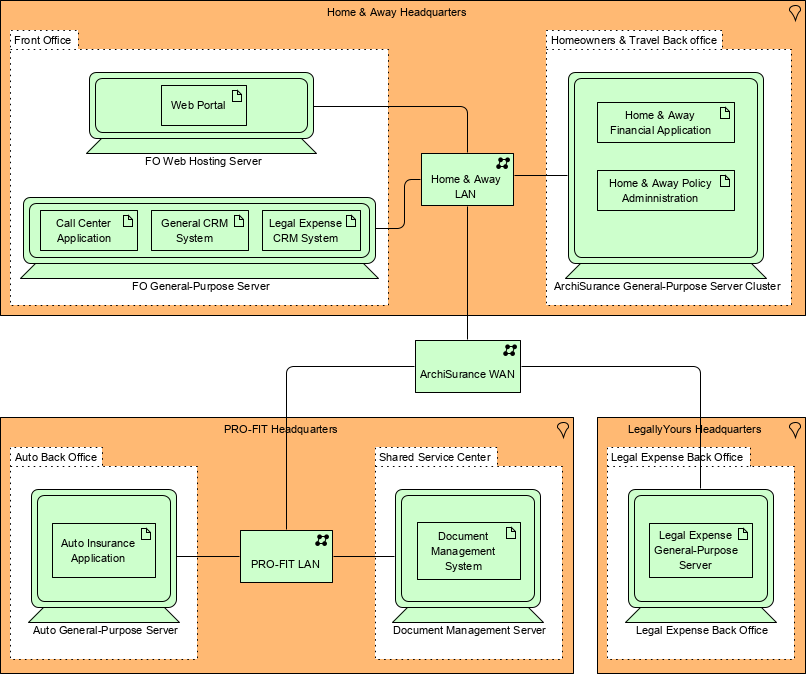
The ArchiMate 3.0 Specification now has a new set of physical elements and their relationships that are based on the Technology Layer. These elements can be used to model physical things like machinery and facilities; a useful example is presented below in the Figure below.
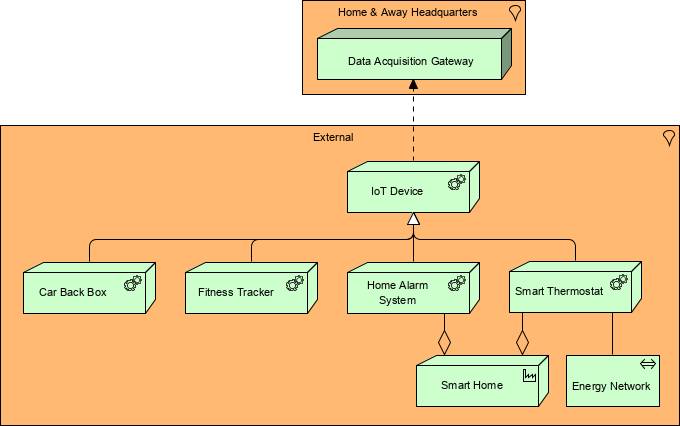
The TOGAF ADM continues with Phases E and F, which deal with choosing solutions and planning the implementation and migration of the architecture from the baseline to the target state. The ArchiMate standard has the Implementation and Migration extension to the core language so that this part of the ADM can be described to the Figure below:
Example: Migration View

Actually not very long ago, modeling EA was symbolized by three things: a pencil, a sheet of paper and notations. However, time marches on and technology evolves. Everything seems to be moving towards going digital. But are you ready to make the jump?
A drawing tool offers speed and momentum to their software modeling work. Used efficiently, digital saves you a ton of time such as nice printing, easier for undo and redo, copy and paste, using shape palette or diagram templates, and etc.
Many people assume that drawing tools and modeling tools are two interchangeable concepts but this is far from true. Actually a modeling tool should offer a lot more capabilities added to a drawing tool through they might seem not so obvious for most of the people.
A drawing tool can’t be considered as a modeling tool unless the tool can “understands” the notation of the diagram, i.e. the connection rules between shapes or model elements. The following points list these additional capabilities of a modeling tool over a drawing tool.
| Drawing Tool | Modeling Tool | |
| Easy to learn | Easy | Need some time |
| Diagram complexity | Only a simple diagram | Handle complex diagram |
| Shared elements in different or projects | No | Yes+ |
| Connection rules | No | Yes+ |
| Sub diagrams | No | Yes |
| Report generation | No | Yes |
| Model consistency and traceability | No | Yes+ |
| Glossary and terms linked with | No | Yes+ |
| Linkage between models | No | Yes+ |
| Collaboration editing | No | Yes+ |
| Versioning and change management | No | Yes+ |
+ Not all modeling tools support these features (while Visual Paradigm supports all the above)

ArchiMate is a good visual language for modeling EA, but it is not a method that provides steps, techniques for guiding you through the entire EA development process. Although ArchiMate can integrate with TOGAF ADM seamlessly and intrinsically by design, to start an EA project only with pencil and papers would be just like we are doing things in the Stone Age without proper tools.
Even though businesses are aware of the advantages of an EA practice, it has never been an easy task to build an Enterprise Architecture. A problem many organizations face is the inability to identify the place to start, and how to get started. The immaturity of Enterprise Architecture results in gaps and hurdles in the early stages that can stop businesses from progressing further with the scheme. In 2007, Gartner found that 40% of Enterprise Architecture initiatives would be stopped and a later survey in 2015 indicates that 70% of businesses were looking to either start or restart an Enterprise Architecture program.
If you Google around for Enterprise Architecture tooling you will probably uncover two alternatives: Established EA tools with very high price tags, yet they only provide a tree-like structure of repository that contains a set of templates you to edit yourselves. The second alternative would be some drawing tools, such as Visio that require excessive management and juggling of information between multiple applications.
TOGAF ADM is the process of developing an enterprise architecture, while Visual Paradigm features a process navigator that guides you through the execution and completion of TOGAF ADM and fully integrated with ArchiMate 3. The figure below shows a screenshot of the TOGAF ADM Guide-Through tool. It shows the steps to perform in phase B of TOGAF ADM.

Broadly speaking, Visual Paradigm features/facilitates the following:
Gap Analysis with ArchiMate 3 – Look at the bottom right. It’s a color legend that enables you to effective apply color code to elements in the diagram.

Sample Screenshot on – Generate TOGAF ADM deliverable once you’ve completed the activities.

To conclude, let’s take a look at the items below for what a good ArchiMate tool should support.